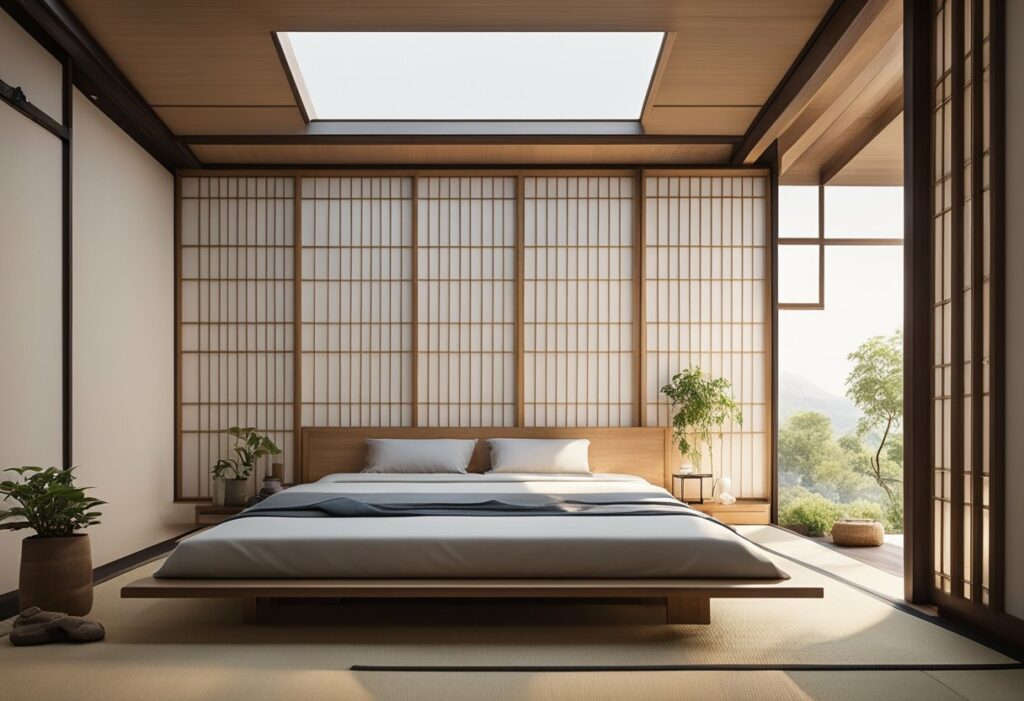Japanese Minimalist Bedroom Design: Creating a Calm and Serene Space
If you’re looking for a bedroom design that exudes simplicity, minimalism, and tranquility, then a Japanese minimalist bedroom might be just what you need. Inspired by the principles of Zen, Japanese-inspired interior design has become increasingly popular in recent years. A Japanese minimalist bedroom design can help you create a serene and calming space where you can relax and unwind after a long day.
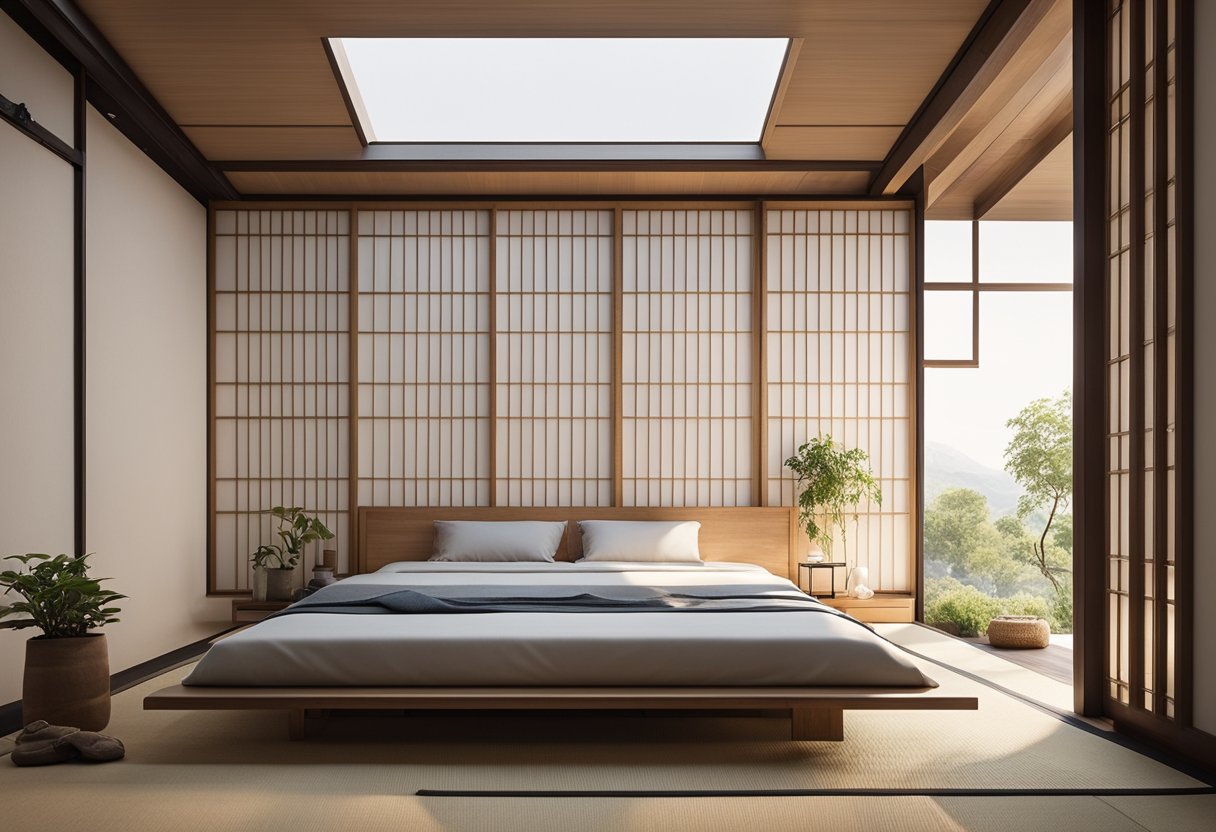
The key to creating a Japanese minimalist bedroom is to focus on simplicity and functionality. In Japanese design, less is often more. By embracing minimalism, you can create a space that is free from clutter and distractions, allowing you to focus on what’s truly important. From the colour scheme to the furniture, every element of a Japanese minimalist bedroom is carefully chosen to create a sense of harmony and balance.
Key Takeaways
- A Japanese minimalist bedroom design is inspired by the principles of Zen and focuses on simplicity and functionality.
- Less is often more in Japanese design, and every element of the bedroom is chosen to create a sense of harmony and balance.
- By embracing minimalism, you can create a serene and calming space where you can relax and unwind after a long day.
Design Principles and Elements
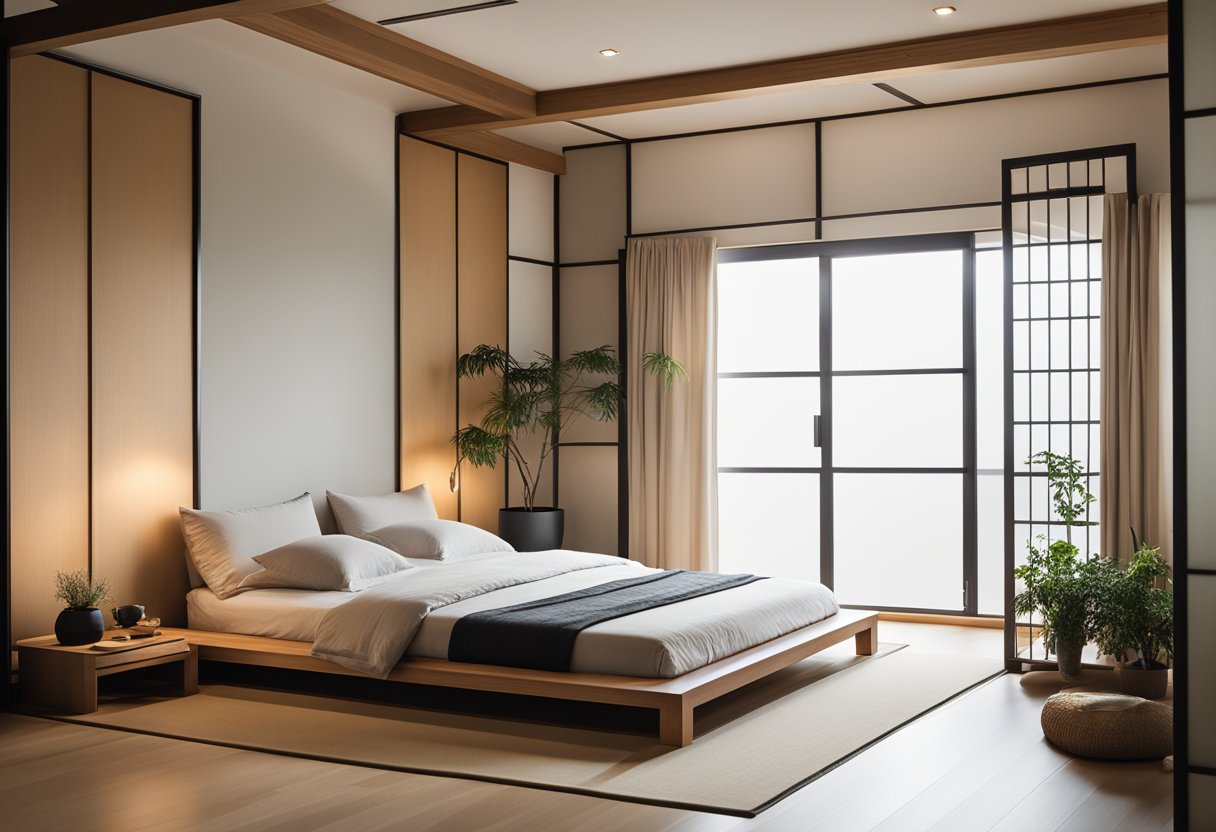
If you’re looking to create a Japanese minimalist bedroom, there are a few design principles and elements you should consider. By incorporating these elements, you can create a harmonious and serene space that promotes relaxation and mindfulness.
Incorporating Japanese Tradition
Japanese minimalist design is heavily influenced by traditional Japanese culture. Incorporating elements of Japanese art, decor, and furniture can help you create an authentic Japanese minimalist bedroom. Consider adding traditional Japanese paintings, known as byobu, to your space. These paintings often feature natural scenes and can help create a calming atmosphere.
Creating a Harmonious Space
Creating a harmonious space is key to Japanese minimalist design. This means selecting furniture and decor that work together to create a balanced and serene atmosphere. Choose furniture made from natural materials such as bamboo or wood, and select a colour palette that includes earthy tones and pastels.
Selecting the Right Materials and Colours
Materials and colours are important elements of Japanese minimalist design. Choose natural materials such as cotton or rice paper for textiles, and consider adding a shoji screen or tatami mats to your space. These elements can help create a calming atmosphere and promote mindfulness. When selecting a colour palette, choose colours that are calming and serene, such as blues and greens.
By incorporating these design principles and elements, you can create a Japanese minimalist bedroom that promotes balance, serenity, and peace. Remember to focus on functionality and decluttering, and to select furniture and decor that work together to create a harmonious space.
Accessories and Final Touches
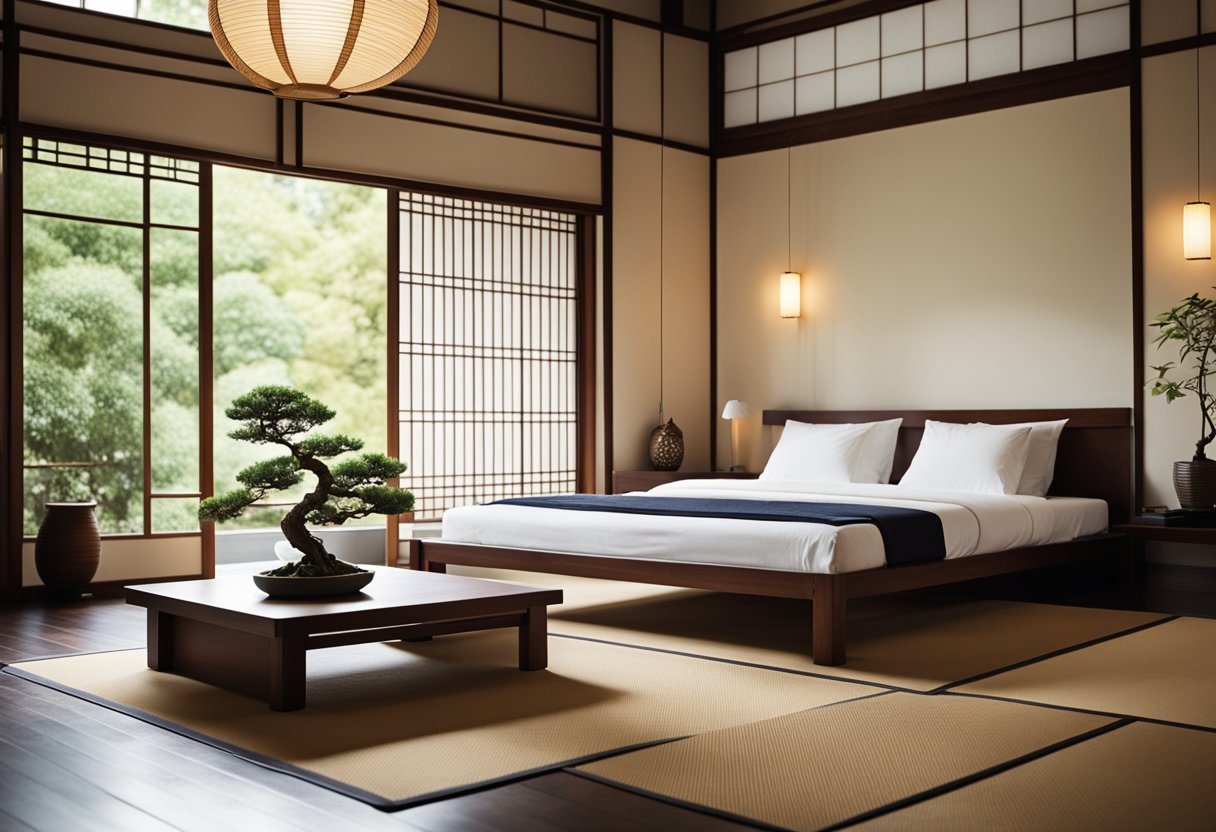
Now that you have the basics of your Japanese minimalist bedroom in place, it’s time to add the finishing touches that will enhance the overall look and feel of your space. Here are some ideas to help you create a serene and harmonious ambiance in your bedroom.
Enhancing with Decorative Elements
When it comes to decorative elements, less is more. Choose items that reflect the principles of Japanese design, such as understated elegance and imperfection. Byobu screens are a great way to add a decorative element to your bedroom while also providing privacy and separating different areas of the room. You can also add a touch of nature with indoor plants or a bonsai tree.
Optimising Light and Ambiance
Lighting is an essential element of any bedroom design, and in a Japanese minimalist bedroom, it’s crucial to get it right. Natural light is the best option, so if you have large windows, make sure to keep them unobstructed. You can also add some soft lighting with lamps or pendant lights to create a relaxing ambiance in the evening.
Focusing on Storage and Organisation
Storage and organisation are essential in any bedroom, but in a Japanese minimalist bedroom, it’s even more crucial. Keep your storage solutions simple and clean-lined, such as a dresser or low tables. Make sure to declutter and keep only what you need, which will help create a sense of calm and relaxation in your space.
Overall, the key to creating a Japanese minimalist bedroom is to focus on clean lines, understated elegance, and simplicity. By incorporating these principles into your design, you’ll create a space that promotes relaxation, rejuvenation, and well-being.
Frequently Asked Questions
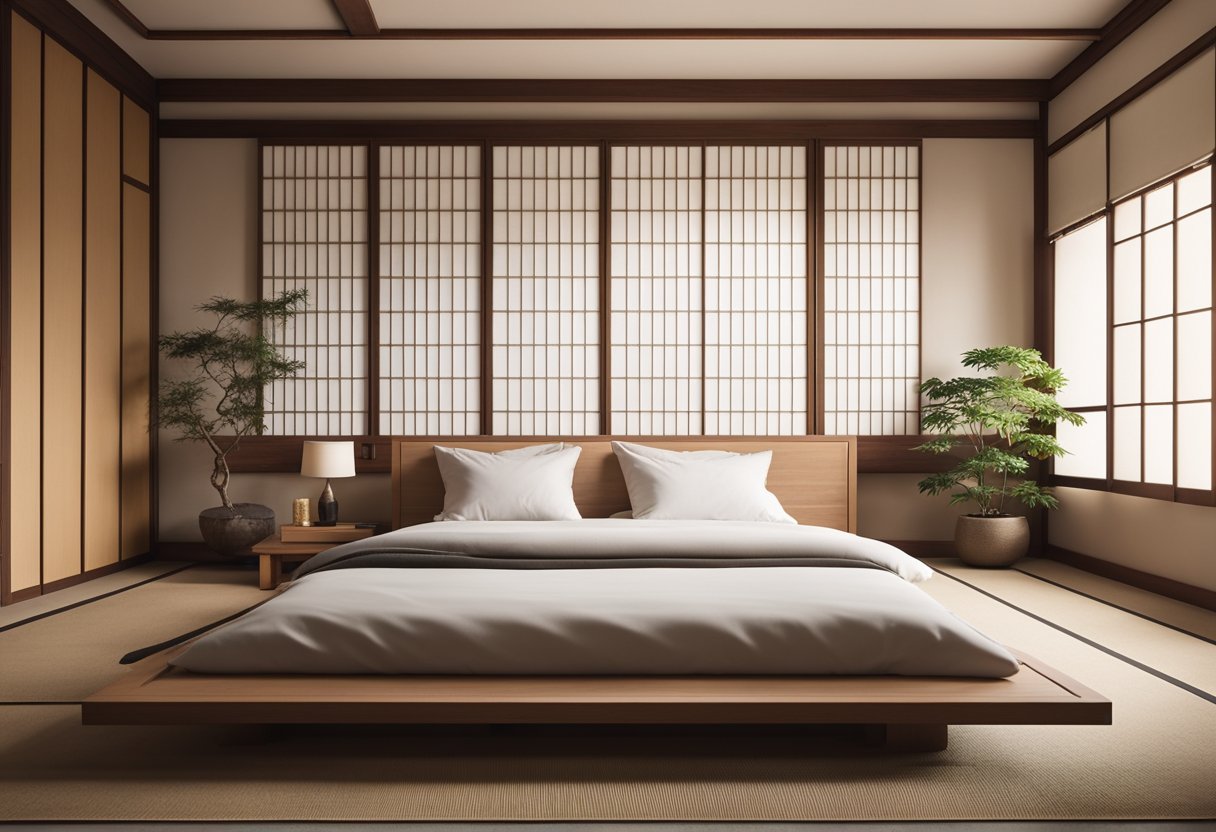
How can I transform my bedroom into a serene Japanese minimalist haven?
Transforming your bedroom into a Japanese minimalist haven is easier than you may think. Start by decluttering your space and removing any unnecessary items. Next, choose a muted colour palette, such as earthy tones, to create a calming atmosphere. Use natural materials, such as wood and cotton, to add warmth and texture to your room. Finally, incorporate traditional Japanese elements, such as shoji screens and tatami mats, to create an authentic and serene atmosphere.
What are the essential elements of a Japanese minimalist bedroom?
Japanese minimalist bedrooms prioritize simplicity, functionality, and tranquillity. The key elements include a low platform bed, shoji screens for windows, tatami flooring, and minimal furniture. Natural light is also essential, so avoid heavy draperies and maximise the amount of light coming into your room.
How do I maximise space in a small room with a Japanese minimalist theme?
Maximising space in a small room can be challenging, but there are a few tricks to help. Choose furniture that is low and simple, such as a platform bed or a low coffee table. Use multifunctional furniture, such as a storage ottoman or a bookshelf that doubles as a room divider. Finally, use wall space to your advantage by installing shelves or hanging plants.
What colour palettes best capture the essence of a Japanese minimalist bedroom?
The best colour palettes for a Japanese minimalist bedroom are muted and natural, such as earthy tones, whites, and greys. These colours create a calming atmosphere and allow the natural materials in your room to shine. You can also add pops of colour with natural accents, such as a vase of flowers or a piece of artwork.
Where can I find inspiration for creating a modern Japanese style bedroom?
There are many sources of inspiration for creating a modern Japanese style bedroom. Start by looking at traditional Japanese design elements, such as shoji screens and tatami mats. You can also look to contemporary Japanese design, which incorporates minimalist and natural elements. Finally, look to nature for inspiration, such as incorporating plants or natural materials like wood and stone.
What types of furniture are characteristic of Japanese minimalist bedrooms?
Japanese minimalist bedrooms feature low and simple furniture, such as a platform bed or a low coffee table. Traditional Japanese furniture, such as a futon or a shoji screen, is also characteristic. The key is to choose furniture that is functional and unobtrusive, allowing the natural materials in your room to shine.

